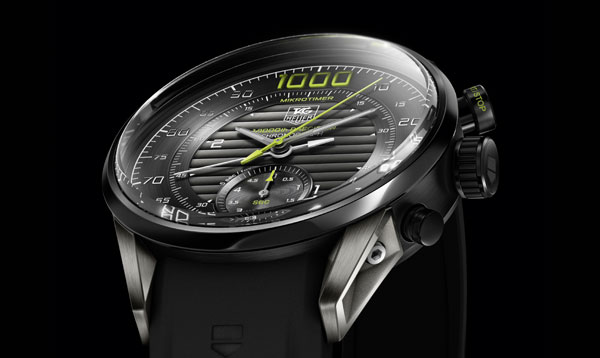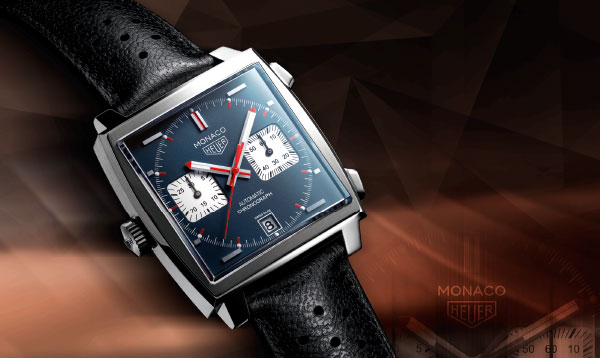
MikrotourbillonS
Case: sandblasted tantalum and 18k pink gold 5N, rubber-moulded crown, sapphire case-back Size : 45mm Movement : self-winding mechanical movement (bi-directional, 45h power reserve, 60mn for the chronograph), 439 components, 4 herz tourbillon for the watch and 2nd 50 herz tourbillon for the chronograph Functions : hour, minute, seconds, 1/100th chronograph, power reserve indicator at 12 Dial : anthracite with Côtes de Genève finishings, open-worked double tourbillon Water-resistance : 100m Strap : hand-sewn anthracite hich tech soft touch alligator with tantalium folding clasp Limited edition
A 1/100th second chronograph and the world’s fastest tourbillon model, equipped with a dual chain and positioned at the peak of the TAG Heuer pyramid, the MikrotourbillonS represents the culmination of five years of research and technological breakthroughs. TAG Heuer has established an authentic R&M strategy embodied by a Fine Watchmaking department that creates several hundred timepieces per year. To appreciate a given unit, one must be able to master the following decimal: such is the principle taken to new extremes by the elite workshop in the Chaux-de-Fonds. Having begun with the Monaco V4 adventure that has been regularly interpreted over recent years through various limited series, the inroads being made into the field of Fine Watchmaking by the brand renowned for its design and its sports timing expertise have been intensified since the start of the decade. In January 2011, the Carrera Mikrograph became the first mechanical chronograph with integrated column-wheel displaying 1/100ths of a second by means of a central hand, followed that same year by the Mikrotimer Flying 1000, the first mechanical chronograph operating at a frequency of 500 Hz (3.6 million vibrations per hour) capable of measuring and displaying 1/1000ths of a second, and then in January 2012 by the Mikrogirder which is accurate to the nearest 5/10,000th of a second. Farewell to the balance-spring, here come micro-blades !
The dual chain system (one for the time and the other for the chronograph function), which was patented for the Mikrograph and does away with the coupling clutch, has become the basic structure for all Mikro models, including the latest, the MikrotourbillonS. The latter is equipped with two tourbillon mechanisms visible on the dial : one for the time (with a frequency of 4 Hertz), and the other for the 1/100th of a second chronograph. Thanks to a dynamic compensation system, it performs 12 revolutions per minute. Another of its stunning technical performances lies in its ability to operate without a carriage, and the fact that it can be started or stopped by means of the dual-chain structure. As with all Mikro products, the demands of the ISO 3159 quality norm (corresponding to COSC requirements) are easily reached. However, the COSC certifies the chronometric or timing precision of watches, not their quality as chronographs – a category for which there is no recognised norm. Concerned with providing optimal customer service, TAG Heuer therefore wanted to consider the creation of a label that would certify the precision of chronographs. When approached on this issue, Besançon Observatory examined the energy best suited to the frequency of the regulator and defined a standard (an important step with a view to establishing a norm) certifying precision for a given duration at a certain frequency : 100 minutes for 5 Hz displaying 1/10th of a second, 10 minutes for 50 Hz displaying 1/100th of a second, and 1 minute for 500 Hz displaying a 1/1000th second movement at 500 Hz. It took the Observatory a year and a half to develop the benchmark capable accurate to the nearest millionth of a second. Which brands other than TAG Heuer can we expect to see submitting their chronographs to this institution ?




